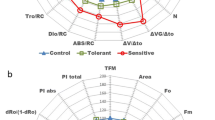Summary
This study assessed 46 potato cultivars, breeding lines and Solanum spp. for heat-tolerance using short-term growth rates and carbon assimilation measurements of young in-vitro-derived plants. Plants of the 46 clones and species were transferred from greenhouse conditions to controlled conditions set at 33/25°C day/night with 12 h photosynthetic photon flux density (PPFD) at 430–450 μmol m-2s-1 and an 8 h daylength extension (6 μmol m-2s-1), to inhibit tuberization. Twenty eight accessions were also grown in a 20/10°C controlled environment. Plants were harvested after 10 and 20 days and dry weights of the plant components were measured for plant growth analysis. Gas exchange (leaf net photosynthesis and maintenance dark respiration) and leaf chlorophyll fluorescence parameters (O, P, and T) were measured at 30°C. Amongst the 30 accessions grown at both hot and cool temperatures, only two accessions (Yungay and AVRDC 1287.19) produced more dry weight in the hot chamber than the cool chamber. Hot/cool ratioss for net assimilation rate (NAR) and relative growth rate (RGR) exceoded unity in five and six accessions, respectively. For the 46 accessions grown under hot conditions, none had significantly greater values than those of the control clones for RGR and NAR. Differences between clones in maintenance respiration and net photosynthesis were more closely related to RGR, NAR, and total dry weight (TDWT) in clones which invested more dry weight in leaves and less in stems. Attributes of the chlorophyll fluorescence curve did not explain more of the clonal variation in RGR, NAR, and TDWT than did gas exchange parameters. No single gas exchange or fluorescence character explained more than 50% of the variability among clones for NAR, RGR, or TDWT, but combination of favourable attributes could improve potato heat tolerance in the future.
Similar content being viewed by others
References
BenKheder & E.E. Ewing, 1985. Growth analysis of eleven potato cultivars grown in the greenhouse under long photoperiods with and without water stress. Am. Potato J. 62: 537–554.
Bushnell, J., 1925. The relation of temperature to growth and respiration in the potato plant. Minnesota Agr. Expt. Sta. Bull. 34.
Carter G.A., A.F. Theisen & R.J. Mitchell, 1990. Chlorophyll fluorescence measured using the Fraunhofer line-depth principle and relationship to photosynthetic rate in the field. Plant, Cell and Env. 13: 79–83.
Dwelle R.B., P.J. Hurley & J.J. Pavek, 1983. Photosynthesis and stomatal conductance of potato clones (Solanum tuberosum L.). Plant Physiol. 72: 172–176.
El-Sharkawy M.A., J.H. Cock, J.K. Lynam, D.P. Hernandez & L. Cadavid, 1990. Relationships between biomass, root yield, and single-leaf photosynthesis in field-grown cassava. Field Crops Res. 25: 183–201.
FAO, 1978. Report on the agro-ecological zones project. Vol. I. Methodology and results for Africa. FAO, Rome. 158 pp.
Hetherington S.E., R.M. Smillie, P. Malagamba & Z. Huaman, 1983. Heat tolerance and cold tolerance of cultivated potatoes measured by the chlorophyll-fluorescence method. Planta 159: 119–124.
Hunt R., 1978. Plant growth analysis. Edward Arnold, London. 67 pp.
Levy D., 1984. Cultivated Solanum tuberosum L. as a source for the selection of cultivars adapted to hot climates. Trop. Agric. (Trinidad) 61: 167–170.
Mendoza H.A. & R.N. Estrada, 1979. Breeding potatoes for tolerance to stress: Heat and frost. In: H. Mussel and R. Staples (Eds.). Stress Physiology in Crop Plants. Wiley, New York. pp. 227–262.
Midmore D.J. & H.A. Mendoza, 1984. Improving adaptation of the potato (Solanum spp.) to hot climates-some physiological considerations. In: Symposium of the International Society for Tropical Root Crops, 6th, 1983. Proceedings. International Potato Center (CIP). Lima, Peru. pp. 457–464.
Midmore, D.J. & R.E. Rhoades, 1987. Applications of agrometeorology to the production of potato in the warm tropics. In: C.J. Stigter (Ed.). Agrometeorology of the Potato. Symposium, Wageningen. 9–10 Apr. 1987. Acta Horticulturae 215: 103–136.
Midmore, D.J. & R.K. Prange, 1991. Growth responses of two Solanum spp. to contrasting temperatures and irradiance levels and their relationship to photosynthesis, dark respiration, and chlorophyll fluorescence. Ann. Bot. (In Press).
Morpurgo R. & R. Ortiz, 1988. Morphological variation of the potato (Solanum spp.) under contrasting environments. Env. and Expt. Bot. 28: 165–169.
Prange R.K., K.B. McRae, D.J. Midmore & R. Deng, 1990. Reduction in potato growth at high temperature: role of photosynthesis and dark respiration. Am. Potato J. 67: 357–369.
Reynolds M.P. & E.E. Ewing, 1989. Heat tolerance in tuberbearing Solanum species: A protocol for screening. Am. Potato J. 66: 63–74.
Reynolds M.P., E.E. Ewing & T.G. Owens, 1990. Photosynthesis at high temperature in tuber-bearing Solanum species. Plant Physiol. 93: 791–797.
Simmonds N.W., 1971. The potential of potatoes in the tropics. Trop. Agric. (Trinidad) 48: 291–299.
Sipos J. & R.K. Prange, 1986. Response of ten potato cultivars to temperature as measured by chlorophyll fluorescence in vivo. Am. Potato J. 63: 683–694.
Smillie R.M., S.E. Hetherington, C. Ochoa & P. Malagamba, 1983. Tolerance of wild potato species from different altitudes to cold and heat. Planta 159: 112–118.
Sunoschi M., B. Costelloe, Y. Lifshitz, H.C. Lee & Y. Roseman, 1987. Arma: A potato cultivar resistant to heat stress. Am. Potato J. 64: 191–196.
Trebejo L. & D.J. Midmore, 1990. Effect of water stress on potato (Solanum spp.) growth, yield, and water use in a hot and a cool tropical climate. J. Agric. Sci. (Camb.) 114: 321–334.
Winkler E., 1971. Kartoffelbau in Tirol. II. Photosynthesevermogen und Respiration von verschiedenen Kartoffelsorten. Potato Res. 14: 1–18.
Wolf S., A.A. Olesinski, J. Rudich & A. Marani, 1990. Effect of high temperatures on photosynthesis in potato. Ann. Bot. 65: 179–185.
Author information
Authors and Affiliations
Rights and permissions
About this article
Cite this article
Midmore, D.J., Prange, R.K. Sources of heat tolerance amongst potato cultivars, breeding lines, and Solanum species. Euphytica 55, 235–245 (1991). https://doi.org/10.1007/BF00021244
Received:
Accepted:
Issue Date:
DOI: https://doi.org/10.1007/BF00021244




